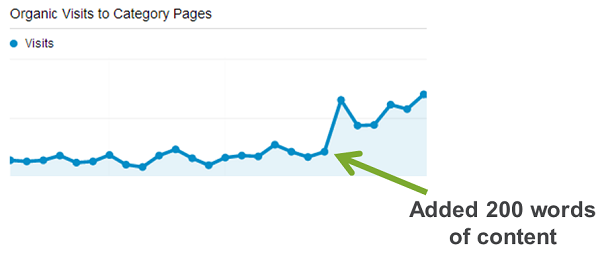What content is ideal for an e-commerce website with categories ?
Should content remain of good quality, engaging and be a source of inspiration ?
Is it recommended to create category footer content just for SEO purposes or should content be created for both the user experience and SEO ?
Google’s John Mueller provided the following advice:
- “E-commerce SEOs often place relevant content about a category in the footer of their e-commerce category pages, hoping it will help the page rank in search. But Google’s John Mueller recently suggested in a webmaster hangout that this isn’t a good idea.”
- “I’d try to stick to really informative content and put that in places where you think that users will be able to see it,” rather than throwing that content on the footer of the page
- In short, John said it is best to have your content integrated into the category pages where the content is useful to the web site visitor. “Things you could do here,” he said, “is kind of make sure that those pages are well-integrated with your website so that we have a clear context of how those pages should belong the website and what those pages are about”
- “But do not just throw content in the footer of the page under the listings for the products.”
See the full Hangouts video below for details.
Here is the transcript:
“Many e-commerce websites optimize their categories by adding a big chunk of text under the product listings. Nothing except an h1 heading above the fold. I don’t consider this good usability since users need to scroll all the way down to read this. Does Google treat this content the same as any other or would you for improving rankings recommend putting the category text above the fold?
So this is something that that comes up fairly regularly.
One of the reasons why websites initially started kind of doing this this kind of workaround is that it was really hard sometimes for us to rank category pages on ecommerce sites if there’s no useful information on that page, if there’s no context on that page. So as a workaround people started stuffing whole Wikipedia articles above below the fold using a small font, sometimes using a link like that says like more information that pops out at this giant article of text.
And from our point of view that’s essentially keyword stuffing. So that’s something worth which I would try to avoid.
I’d try to stick to really informative content and put that in place where you think that users will be able to see it. Especially if it is content that you want to provide for users. And more than that I would think about what you can do to make those pages rank well without having to put a giant paragraph of content below the page.
So things you could do here is kind of make sure that those pages are well integrated with your website so that we have clear context of how those pages should belong the website and what those pages are about. And another thing you can do is when you have that listing of products, make sure that there’s some information on that on those listings that we can understand what this page is about.
So instead of just listing I don’t know 40 photos of your product, put some text on there. Make sure that you have alt text for the images, that you have captions below their images. So that when we look at this page we understand oh there’s this big heading on top that’s telling us like this is the type of product that you have on your website and there’s lots of product information in those listings and we can follow those listings to do even more information so that you don’t need to put this giant block of text on the bottom. Obviously having some amount of text makes sense. So maybe shifting that giant block of text into maybe one or two sentences that you place above the fold below the heading is a good approach here because it also gives users a little bit more information about what they should expect on this page. So that’s that’s kind of the direction I would head there.
I’d really try to avoid the situation where you’re kind of fudging a page by putting tons of text on the bottom of the page just because of the rest of the page is suboptimal and instead try to find ways to improve the page overall so that you don’t have to go this workaround.”

